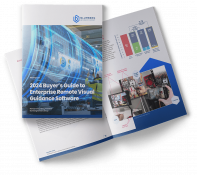Help Lightning Blog
How To Address Your Workforce Skills Gap With Remote Assistance Software

There is no denying that a gap exists between the skills that many companies need and the skills that those seeking jobs have to offer. The need to address your workforce skills gap is an especially high priority for entry-level positions as many of these target new college grads. The infamous ‘two years of experience’ requirement for most jobs is often overlooked by both employers and job seekers because it doesn’t always make sense. But what if there was a way to train inexperienced or less experienced new hires without the need for heavy oversight?
People with more experience demand higher pay, but employers aren’t as willing to pay those higher salaries, so they end up accumulating employees who may not know everything they need to succeed in their position. If you enact a system that can help new hires get up to speed as fast as possible, you won’t need to worry about ensuring every hire is an expert in their field.
Augmented reality (AR) in the form of Remote Visual Assistance (RVA) software is a potential solution to the many woes related to the workforce skills gap. In industries where employees commonly learn on the job and can only gain their skills by experience, RVA can add an extra layer of support that ensures they can troubleshoot and succeed.
Remote Assistance Software Bridges the Workforce Skills Gap
Remote visual assistance works through video collaboration facilitated by a portable piece of tech the employee already has in their possession, like a tablet or smartphone. A new hire and an expert – even two people who are thousands of miles away from each other – can work virtually side-by-side with the use of two merged video streams and 3D annotations. Essentially, your employees don’t have to be in the same place and can still communicate as if they were together in person.
This is a huge advantage for organizations that need to hire many new employees at a starting salary but need them trained and functional as quickly as possible. These workers can develop their skillset on the job by taking a tablet o smartphone with them to the job site. Anytime they are confused or uncertain, they can pull out their device and request help via remote visual assistance software, connecting with an expert.
Training programs can be costly and use up a lot of resources. This has a significant impact on the most skillful of your senior employees, who are burdened with micromanagement and pedagogy rather than the work on which they need to focus. Remote assistance takes the time and physical location burden off their shoulders.
Instead, new hires can interface with these experts as needed while the more experienced professionals spend their available time on the projects they care about. It is also a lot easier for the human resources department to provide their assistance when they know they can access support from experts. They will feel confident implementing training protocols with the option to consult a leader in the trainee’s field.
Where Remote Assistance Has the Greatest Opportunity to Address Your Workforce Skills Gap
Some industries are certainly more primed for the technological advancement of AR-enabled software. Jobs that require being out in the field, like real estate appraiser, environmental consultant, medical equipment technicians, plumber, HVAC installers, service technicians, and more can benefit the most. Fledgling workers (or your customers who rely upon your manufactured equipment) in any of these areas will benefit from being able to engage in trial and error supported by remote assistance.
Now more than ever, virtual capabilities are even more important. Many employees, especially more seasoned ones, have the option to work from home or remotely for part of the week. It is not going to be pretty if you have to pull them away from this perk to train new employees. Remote assistance allows senior employees to continue working remotely while still contributing to others’ skill development.
Systematic training is the key to reducing the workforce skills gap. Especially as technology continues to advance rapidly, new tools are constantly released, and the workforce evolves, the most beneficial quality of a new hire is passionate commitment. It is not as crucial that they know everything they need to know or have decades of experience. With the right tools on hand, all they need is a desire to succeed and a willingness to learn. New to this technology? Download this 2021 buyer’s guide.
How to Get More Information
Whether your employees need to conduct complex quality assurance initiatives, sell products or services, or venture into new territory to solve problems, they can learn on the go with remote assistance software. Check out everything you need to know and more when it comes to augmented reality and remote assistance from Help Lightning. Request a free demo today.












